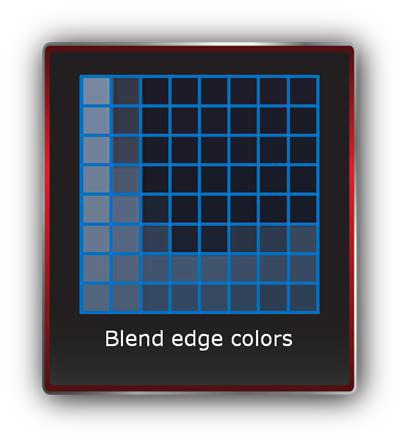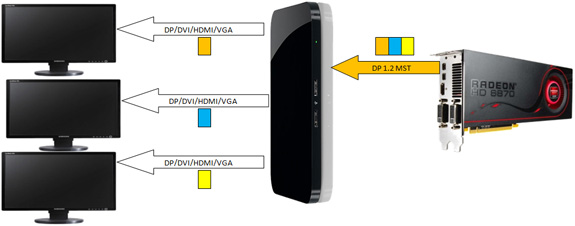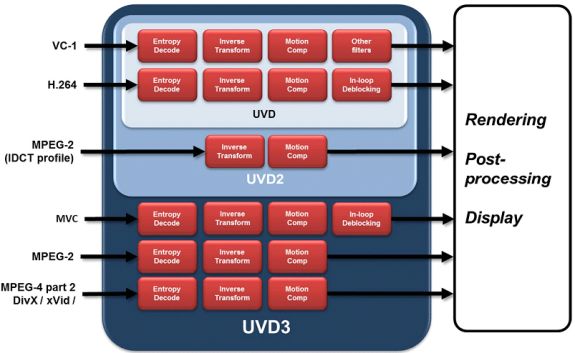AMD's Radeon HD 6970 & Radeon HD 6950: Paving The Future For AMD
by Ryan Smith on December 15, 2010 12:01 AM ESTRefresher: The 6800 Series’ New Features
Back in October AMD launched the first 6000 series cards, the Barts-based Radeon HD 6800 series. At their core they are a refreshed version of the Cypress GPU that we saw on the 5800 series, but AMD used the opportunity to make some enhancements over the standard Cypress. All of these enhancements apply throughout the 6000 series, so this includes the 6900 series. As such for those of you who didn’t pay much attention to the 6800 series, we’re going to quickly recap what’s new in order to lay the groundwork for further comparisons of the 6900 series to the 5800 series.
We’ll start with the core architecture. Compared to Cypress, Barts is nearly identical save 1 difference: the tessellator. For Barts AMD implemented what they call their 7th generation tessellator, which focused on delivering improved tessellation performance at lower tessellation factors that AMD felt were more important. Cayman takes this one step further and implements AMD’s 8th generation tessellator, which as the naming conventions implies is the 7th generation tessellator with even further enhancements (particularly those necessary for load balancing).
The second change we saw with Barts and the 6800 series was AMD’s refined texture filtering engine. AMD’s texture filtering engine from the 5800 set new standards by offering angle independent filtering, but it had an annoying quirk with highly regular/noisy textures where it didn’t do a good enough job blending together various mipmaps, resulting in visible transitions between them. For the 6800 series AMD fixed this, and it can now properly blend together noisy textures. At the same time in a controversial move AMD tweaked its default filtering optimizations for the 5800 series and entire 6000 series, leading to these cards producing imagines subtly different (and depending on who you ask, subtly worse) than they were on the 5800 series prior to the Catalyst 10.10 drivers.

| Radeon HD 5870 | Radeon HD 6870 | GeForce GTX 480 |
The third change we saw was the introduction of a new anti-aliasing mode, initially launched on the 6800 series and backported to the 5800 series shortly thereafter. Morphological Anti-Aliasing (MLAA) is a post-processing filter that works on any (and all) images, looking for high contrast edges (jaggies) and blending them to reduce the contrast. Implemented as a compute shader, it works with all games. As it’s a post-processing filter the results can vary – the filter has no knowledge of depth, polygons, or other attributes of the rendered world beyond the final image – so it’s prone to blending everything that looks like aliasing. On the plus side it’s cheap to use as it was originally designed for consoles with their limited resources, so by not consuming large amounts of memory & memory bandwidth like SSAA/MSAA it usually has a low performance hit.


Last but not least, AMD made a number of changes to their display hardware. The Universal Video Decoder (UVD) was upgraded to version 3, bringing full decode support for MPEG-2, MPEG-4 ASP, and H.264 MVC (packed frame video for 3D movies). For the 6900 series this is not of great importance as MPEG-2 and MPEG-4 ASP are low complexity codecs, but it does play an important role for AMD’s future APU products and low-end GPUs, where offloading these low complexity codecs is still going to be a big relief for the slower CPUs they’re paired with. And on that note the first public version of the DivX codec with support for UVD3 will be shipping today, letting 6800/6900 series owners finally take advantage of this functionality.
The second of the major display changes was the addition of support for the DisplayPort 1.2 standard. DP1.2 doubles DisplayPort’s bandwidth to 21.6Gbps, finally giving DisplayPort a significant bandwidth lead over dual-link DVI. With double the bandwidth it’s now possible to drive multiple monitors off of a single root DisplayPort, a technology called Multi Stream Transport (MST). AMD is heavily banking on this technology, as the additional bandwidth coupled with the fact that DisplayPort doesn’t require a clock source for each monitor/stream means AMD can drive up to 6 monitors off of a single card using only a pair of mini-DP ports. AMD is so cutting edge here that like the 6800 series the 6900 series is technically only DP1.2 ready – there won’t be any other devices available for compliance testing until 2011.

Finally, the 6800 series also introduced support for HDMI 1.4a and support for color correction in linear space. HDMI 1.4a support is fairly straightforward: the 6000 series can drive 3D televisions in either the 1080p24 or 720p60 3D modes. Meanwhile support for color correction in linear space allows AMD to offer accurate color correction for wide gamut monitors; previously there was a loss of accuracy as color correction had to be applied in the gamma color space, which is only meant for use for display purposes. This is particularly important for integrating wide gamut monitors in to traditional gamut workflows, as sRGB is misinterpreted on a wide gamut monitor without color correction.
While all of these features were introduced on the 6800 series, they’re fundamental parts of the entire 6000 series, meaning they’re part of the 6900 series too. This provides us with a baseline set of improvements over AMD’s 5800 series, on top of the additional improvements Cayman and AMD’s VLIW4 architecture brings.











168 Comments
View All Comments
MeanBruce - Wednesday, December 15, 2010 - link
TechPowerUp.com shows the 6850 as 95percent or almost double the performance of the 4850 and 100percent more efficient than the 4850@1920x1200. I also am upgrading an old 4850, as far as the 6950 check their charts when they come up later today.mapesdhs - Monday, December 20, 2010 - link
Today I will have completed by benchmark pages comparing 4890, 8800GT and
GTX 460 1GB (800 and 850 core speeds), in both single and CF/SLI, for a range
of tests. You should be able to extrapolate between known 4850/4890 differences,
the data I've accumulated, and known GTX 460 vs. 68xx/69xx differences (baring
in mind I'm testing with 460s with much higher core clocks than the 675 reference
speed used in this article). Email me at mapesdhs@yahoo.com and I'll send you
the URL once the data is up. I'm testing with 3DMark06, Unigine (Heaven, Tropics
and Sanctuary), X3TC, Stalker COP, Cinebench, Viewperf and PT Boats. Later
I'll also test with Vantage, 3DMark11 and AvP.
Ian.
ZoSo - Wednesday, December 15, 2010 - link
Helluva 'Bang for the Buck' that's for sure! Currently I'm running a 5850, but I have been toying with the idea of SLI or CF. For a $300 difference, CF is the way to go at this point.I'm in no rush, I'm going to wait at least a month or two before I pull any triggers ;)
RaistlinZ - Wednesday, December 15, 2010 - link
I'm a bit underwhelmed from a performance standpoint. I see nothing that will make me want to upgrade from my trusty 5870.I would like to see a 2x6950 vs 2x570 comparison though.
fausto412 - Wednesday, December 15, 2010 - link
exactly my feelings.it's like thinking Miss Universe is about to screw you and then you find out it's her mom....who's probably still hot...but def not miss universe
Paladin1211 - Wednesday, December 15, 2010 - link
CF scaling is truly amazing now, I'm glad that nVidia has something to catch up in terms of driver. Meanwhile, the ATI wrong refresh rate is not fixed, it stucks at 60hz where the monitor can do 75hz. "Refresh force", "refresh lock", "ATI refresh fix", disable /enable EDID, manually set monitor attributes in CCC, EDID hack... nothing works. Even the "HUGE" 10.12 driver can't get my friend's old Samsung SyncMaster 920NW to work at its native 1440x900@75hz, both in XP 32bit and win 7 64bit. My next monitor will be an 120hz for sure, and I don't want to risk and ruin my investment, AMD.mapesdhs - Monday, December 20, 2010 - link
I'm not sure if this will help fix the refresh issue (I do the following to fix max res
limits), but try downloading the drivers for the monitor but modify the data file
before installing them. Check to ensure it has the correct genuine max res and/or
max refresh.
I've been using various models of CRT which have the same Sony tube that can
do 2048 x 1536, but every single vendor that sells models based on this tube has
drivers that limited the max res to 1800x1440 by default, so I edit the file to enable
2048 x 1536 and then it works fine, eg. HP P1130.
Bit daft that drivers for a monitor do not by default allow one to exploit the monitor
to its maximum potential.
Anyway, good luck!!
Ian.
techworm - Wednesday, December 15, 2010 - link
future DX11 games will stress GPU and video RAM incrementally and it is then that 6970 will shine so it's obvious that 6970 is a better and more future proof purchase than GTX570 that will be frame buffer limited in near future gamesNickel020 - Wednesday, December 15, 2010 - link
In the table about whether PowerTune affects an application or not there's a yes for 3DMark, and in the text you mention two applications saw throttling (with 3DMark it would be three). Is this an error?Also, you should maybe include that you're measuring the whole system power in the PowerTune tables, it might be confusing for people who don't read your reviews very often to see that the power draw you measured is way higher than the PowerTune level.
Reading the rest now :)
stangflyer - Wednesday, December 15, 2010 - link
Sold my 5970 waiting for 6990. With my 5970 playing games at 5040x1050 I would always have a 4th extended monitor hooked up to a tritton uve-150 usb to vga adapter. This would let me game while having the fourth monitor display my teamspeak, afterburner, and various other things.Question is this!! Can i use the new 6950/6970 and use triple monitor and also use a 4th screen extended at the same time? I have 3 matching dell native display port monitors and a fourth with vga/dvi. Can I use the 2 dp's and the 2 dvi's on the 6970 at the same time? I have been looking for this answer for hours and can't find it! Thanks for the help.